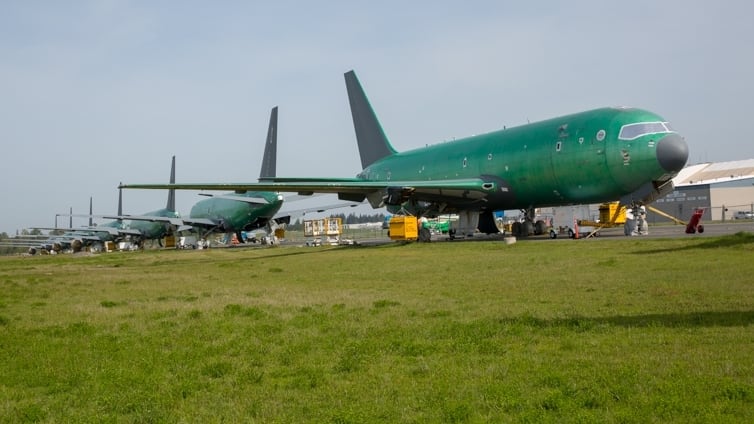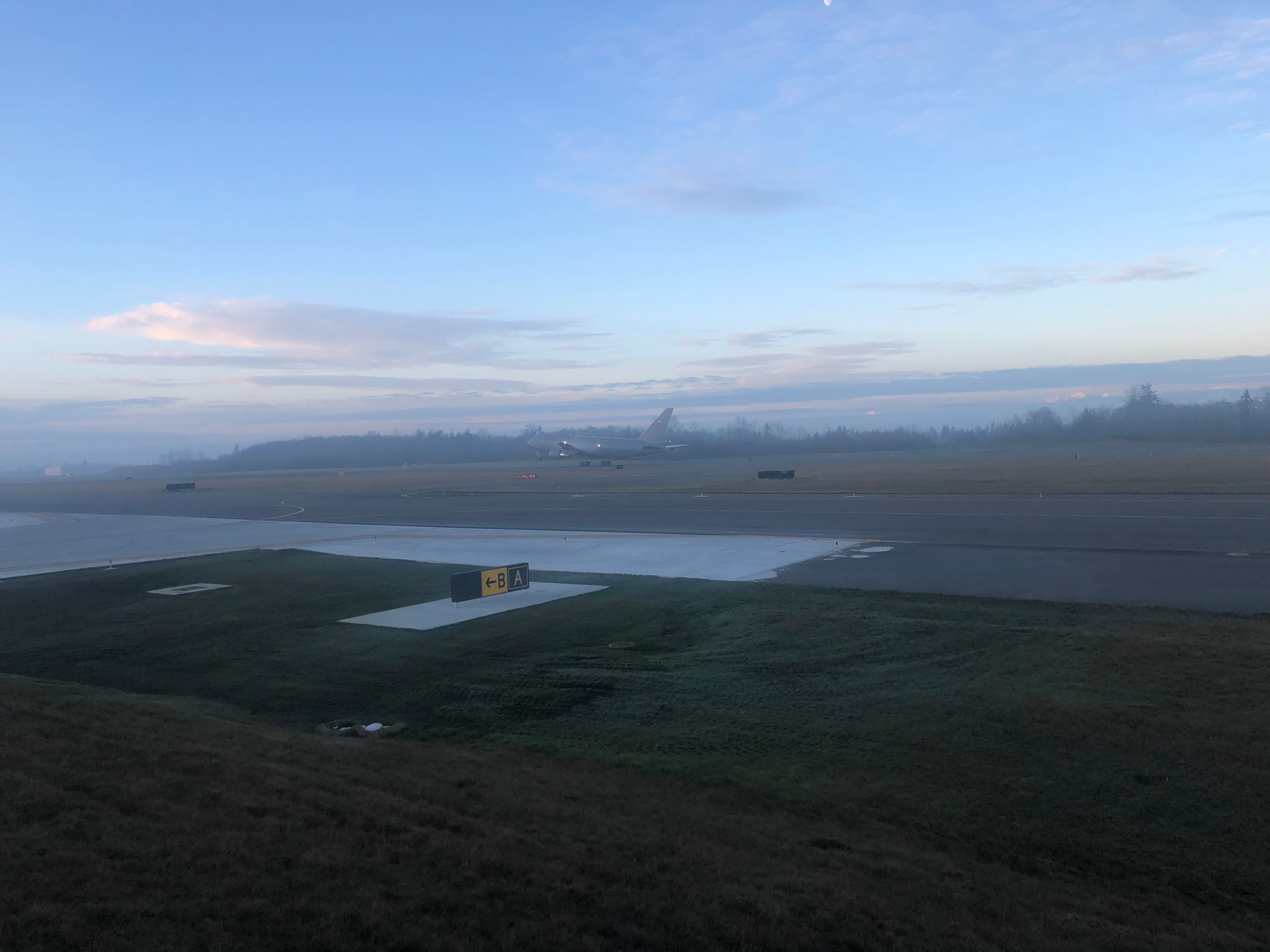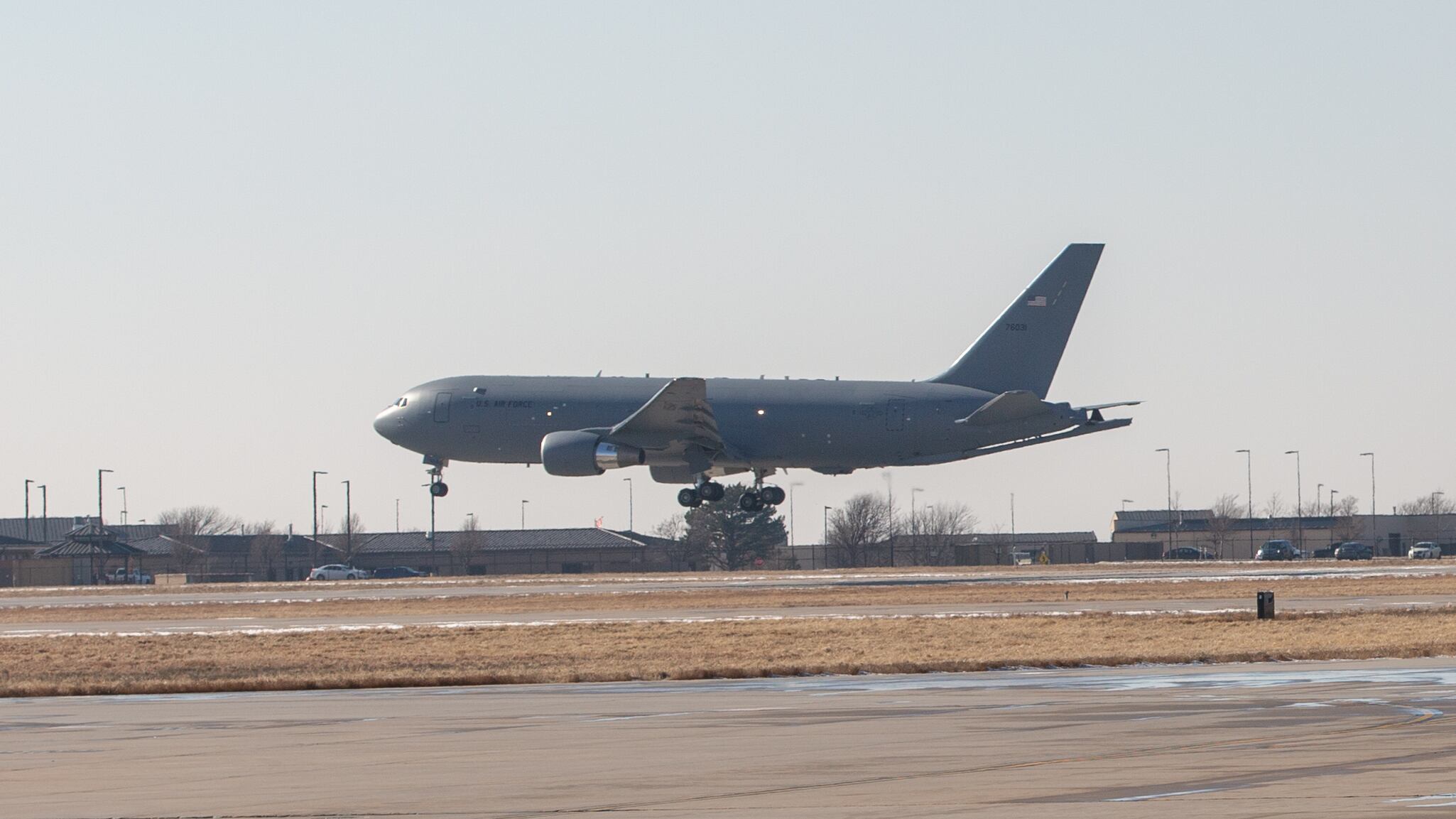EVERETT, Wash., and MCCONNELL AIR FORCE BASE, Kan. — On the chilly morning of Jan. 25, just as the sun was beginning to rise, two KC-46 refueling tankers took off from Boeing’s Everett, Washington, delivery center and began flying toward McConnell Air Force Base in Kansas. Later that day, it touched down, to cheers from airmen assigned to the base’s 22nd Air Refueling Wing.
It took only minutes for the aircraft to taxi and take to the skies — a welcome lack of drama for a program that has seen prolonged challenges: a virulent competition between two companies, two years of schedule delays and more than $3 billion in cost overruns that manufacturer Boeing had to pay out of pocket.
RELATED

The delivery of the first two KC-46 Pegasus planes was almost two decades in the making. As such, the event was treated as a momentous celebration by Boeing officials, who held a ceremony Thursday marking the occasion with its Air Force customer.
On Friday, Air Force leadership, congressional representatives and Boeing executives witnessed the aircraft’s arrival at McConnell for yet another event.
“To me, its personal to bring on this capability,” Air Force Chief of Staff Gen. David Goldfein said after arriving on base. “This is a big day for us.”
“I think we all know the journey over the last several years,” Boeing CEO Dennis Muilenburg said Thursday. “It hasn’t been easy. In fact, it’s been hard. But this team stuck to it. This team worked together.”
At the Everett ceremony, Boeing brought in a band to play classic rock songs by the likes of Jimi Hendrix and Led Zeppelin before the ceremony, dispersed cookies and chocolate lollipops featuring the KC-46, and had a tanker-themed “selfie station” where visitors could take photos of themselves with the Pegasus on display.

Over the KC-46 flight test program, the aircraft clocked 3,800 hours in the sky and pumped more than 4 billion pounds of fuel, Muilenburg said.
Leanne Caret, who heads Boeing’s defense business, said the delivery solidifies the firm’s legacy as “the tanker company for the U.S. and the world.”
“We’re looking at delivering not only great capability that works today, but we’re looking at staying on that leading edge of technology going forward, and we will continue to lean in throughout this process,” she told reporters after the event.
But numerous obstacles remain. Boeing needs to correct the KC-46’s deficient remote vision system — the series of cameras and sensors that are the sole source of situational awareness for boom operators trying to move fuel from the tanker to a receiver aircraft. The company is redesigning that system at its own expense, and Caret declined to comment on the projected costs of the upgrades.
In order to hit a contractually obligated milestone, it also needs to move forward with getting wing aerial-refueling pods certified by the Federal Aviation Administration, an event that Air Force Secretary Heather Wilson confirmed will not happen until 2020.
Despite those problems, Air Force officials sounded an optimistic note about the current status of the program.
Wilson, who previously criticized Boeing for seemingly not paying enough attention to the tanker’s problems, touted the new capabilities the KC-46 will bring to the tanker force, such as infrared countermeasures, protection against electromagnetic pulses and armor that will make it more survivable in the field.
“This aircraft is able to defend itself in ways that the KC-135 can’t. It also has some other capabilities that allow us to refuel completely in the dark,” she said. “So there are things about this aircraft that we’re really keen to get into the hands of our airmen.”

Goldfein didn’t appear to be worried about the ongoing deficiencies, telling Defense News on Friday that “this is why we do operational test[ing]” and that the Air Force and Boeing had been through “significant” negotiations to get to this point.
“We ended up, I believe, in a good place, and so now its time to get this aircraft in the hands of the war fighter and the operators to let them flesh out all of the operating concerns," he said. “That is part of the normal business of operational testing.”
That operational testing will be led by the 344th Air Refueling Squadron, part of the 22nd Air Refueling Wing at McConnell. The wing will receive two tankers during the ceremony and two later this month. Altus AFB in Oklahoma, set to be the formal KC-46 training base, and it will receive its first aircraft next month.

The service agreed to accept three aircraft a month, but Goldfein said increasing that rate is a possibility later this year, depending on the ability of the Air Force to receive the aircraft.
“Not only do they have to have the capacity to push aircraft, we have to have the capacity to receive aircraft,” Goldfein said.
Fixing the Remote Vision System
Boeing’s biggest hurdle is fixing the Rockwell Collins-made Remote Vision System, a novel tanker technology that has posed some challenges and could take three to four years to fix.
With legacy tankers like the KC-135 and KC-10, boom operators looked out a window at the rear of the plane and used visual cues to guide the boom into a receiver, but the KC-46 moves the boom operators toward the cockpit in more comfortable work stations.
The advantage of the RVS is that it incorporates a panoramic display of visual and infrared cameras that can provide high fidelity imagery in bad weather conditions or even at night time, and without needing to create ambient light that may make the tanker less survivable.
The problem is that during sunny conditions, at certain angles, the sun creates a glare that increases the risk of the boom scraping the receiver aircraft.
Wilson compared the problems with the RVS to what one might find with a backup camera in a vehicle—in certain lighting conditions, the imagery isn’t always perfectly clear.
In other cases, “there’s a bit of a stretch effect, like if you had a piece of rubber and you pulled it at the edges. There’s a little bit of distortion,” she said.
Wilson said the system is safe to use the way it is, but that operators may have to take some mitigating steps in certain conditions. For instance, the KC-46 will not be able to refuel as it moves directly away from the sun, so the tanker will just have to change the direction it is facing during that refueling.
Under the terms of the contract, the Air Force pays Boeing upon each delivery of a new KC-46, but the service is withholding $28 million per plane due to ongoing complications with the RVS. However, Wilson said the service has identified “nine parameters” that it wants the company to meet as it upgrades the RVS, and that as it meets those, it will begin reducing the amount withheld when aircraft delivery.
With improved software developed over the past year, boom operators can now optimize RVS imagery by toggling between different lighting modes that provide various levels of contrast, said Mike Gibbons, Boeing’s KC-46 program manager. But the Air Force wants that process to be automated, so boomers have less work to do.
To get the RVS to that stage, it will need a “rather significant” upgrade of new hardware and software, and Boeing may potentially recompete elements of the system if needed, Gibbons said.
“We would prefer not to have to do that because frankly, it's always better in an enhancement to be able to stick with the architecture and the hardware that we already have. It will be lower risk,” he said.
Fixing the KC-46 boom
Meanwhile, the Air Force has the lead on making changes to the KC-46 boom, which it is funding with taxpayer money.
Wilson explained that the service agreed to fund and develop this fix independently because Boeing met the requirement to provide a boom that met international standards. However, it doesn’t properly disconnect from the A-10 Warthog due to the aircraft’s light weight.
“It’s a fairly simple fix,” she said. “It’s an actuator fix just to make that boom a little bit more sensitive for some of our lighter aircraft. That’s at the Air Force’s expense because Boeing met the requirement. So we will do the design of that.”
Defense News is on the ground at McConnell Air Force Base, traveling with Gen. Goldfein, and at Boeing’s plant in Everett. Stay tuned as this story develops.
Valerie Insinna is Defense News' air warfare reporter. She previously worked the Navy/congressional beats for Defense Daily, which followed almost three years as a staff writer for National Defense Magazine. Prior to that, she worked as an editorial assistant for the Tokyo Shimbun’s Washington bureau.
Jeff Martin is the Associate Editor for Multimedia and the host & producer of Defense News Weekly, airing online and on American Forces Network worldwide. In his role as Associate Editor, he reports worldwide on the military and defense industry and leads a market-leading multimedia team.




